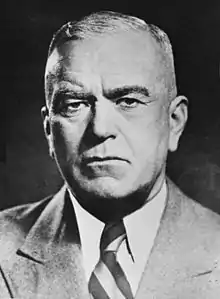1948 Romanian legislative election
Parliamentary elections were held in Romania on 28 March 1948.[1] They were the first elections held in the newly formed Romanian People's Republic, with King Michael having been forced to abdicate in December 1947.[2]
| |||||||||||||||||||||||||||||||||||||
All 414 seats in the Great National Assembly 208 seats needed for a majority | |||||||||||||||||||||||||||||||||||||
|---|---|---|---|---|---|---|---|---|---|---|---|---|---|---|---|---|---|---|---|---|---|---|---|---|---|---|---|---|---|---|---|---|---|---|---|---|---|
| |||||||||||||||||||||||||||||||||||||
| |||||||||||||||||||||||||||||||||||||

With all meaningful opposition having been eliminated, the People's Democratic Front, dominated by the Communist Romanian Workers Party (PMR) received 93.2% of the vote[3] and won 405 of the 414 seats in the Great National Assembly.[4] Within the Front, the PMR and its allies won a total of 201 seats, seven short of a majority in its own right.[5] Rump Liberal and Peasant parties appeared on the ballot, between them receiving 3.5 percent of the vote and winning nine seats.
Background
The Communists, with the help of Prime Minister Petru Groza, had spent the previous two years after the elections of 1946 consolidating their control.The turning point came in the second half of 1947, when the government initiated a campaign of harsh repression against the remaining opposition parties. The National Peasants' Party and National Liberal Party, the two largest opposition parties, were dissolved by the government.[2] The National Peasants' leaders, Iuliu Maniu and Ion Mihalache, were tried on charges of plotting to overthrow the government in the Tămădău Affair, and were both sentenced to life imprisonment.[2] On 30 December, Groza and Communist leader Gheorghe Gheorghiu-Dej confronted Michael and forced his abdication.[2] Michael and his personal counselor would later claim this was done with the help of a detachment of troops from the pro-Communist Tudor Vladimirescu Division.[6][7][8][9] Hours later, the Communist-dominated legislature abolished the monarchy and proclaimed Romania a "people's republic".
A month before the elections, the Communists and part of the Social Democrats merged to form the Romanian Workers' Party (PMR). However, Communists retained key posts in the new party, and used the principle of democratic centralism to ensure that the Social Democratic part of the new party complied with the new order.[2] At the same time, the National Democratic Front, an electoral alliance dominated by the PMR, was reorganized as the People's Democratic Front.[2] The Front rapidly took on a character similar to other "national fronts" in the emerging Soviet bloc. The front's minor parties became completely subservient to the PMR, and had to accept the PMR's "leading role" as a condition of their continued existence. Despite this, Groza, leader of one of those minor parties, the Ploughmen's Front, remained prime minister.
Results
| Party | Votes | % | Seats |
|---|---|---|---|
| People's Democratic Front[lower-alpha 1] | 6,959,936 | 93.2 | 405 |
| National Liberal Party–Bejan | 212,438 | 2.8 | 7 |
| Democratic Peasants' Party | 50,532 | 0.7 | 2 |
| Independent candidates | 245,635 | 3.3 | 0 |
| Invalid/blank votes | 192,490 | – | – |
| Total | 7,661,031 | 100 | 414 |
| Registered voters/turnout | 8,399,416 | 91.2 | – |
| Source: Nohlen & Stöver | |||
- Within the People's Democratic Front, the Romanian Workers Party won 190 seats, PMR affiliates won 11, the Ploughmen's Front won 126, the National Popular Party won 43, the Hungarian People's Union won 30 (shown above in green), and the Jewish Democratic Committee won 5 (shown above in lightblue).[5]
Aftermath
A month after the elections, the legislature adopted a new constitution. While all power was nominally derived from the will of the people through the GNA, in practice power was exercised by the PMR, which itself was closely supervised by the Kremlin.[10] Soon afterwards, all parties outside the People's Democratic Front ceased to exist, though Romania had effectively been a single-party state since the monarchy was abolished in December.
References
- Nohlen, D & Stöver, P (2010) Elections in Europe: A data handbook, p1591 ISBN 978-3-8329-5609-7
- Romania: Elimination of Opposition Parties Library of Congress Country Studies
- Nohlen & Stöver, p1604
- Nohlen & Stöver, p1610
- Cristian Preda - "Rumânii fericiţi"
- (in Romanian) "King Michael between the ascension to the throne and abdication – VII", Ziarul financiar, 24 June 2001
- "Archived copy" (in Romanian). Archived from the original on 2009-10-27. Retrieved 2016-10-03.CS1 maint: archived copy as title (link), undated interview with H.M. King Michael in Ziua, as of 15 October 2008
- "Compression", Time, 12 January 1948
- (in Romanian) Mircea Ionnitiu : "30 December 1947", site dedicated to HM King Mihai I of Romania and to the Romanian Monarchy as of 15 October 2008
- Romania: Three Constitutions Library of Congress Country Studies


